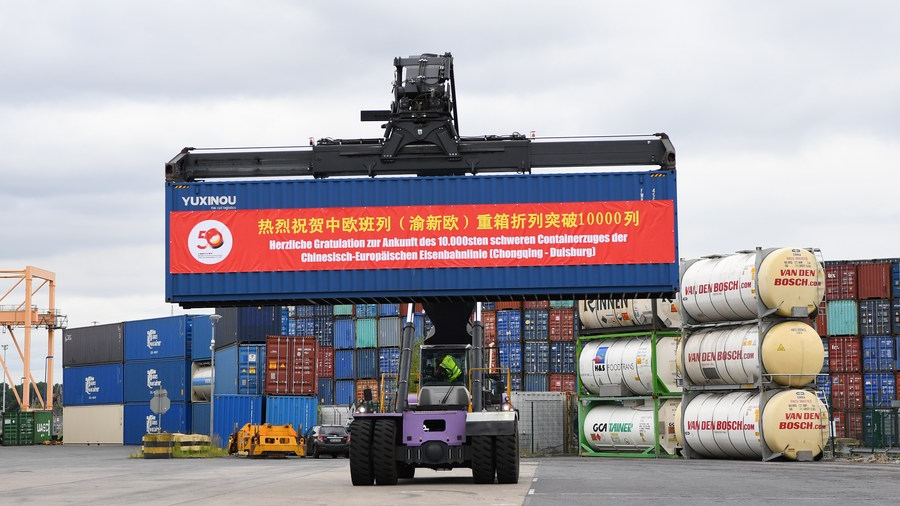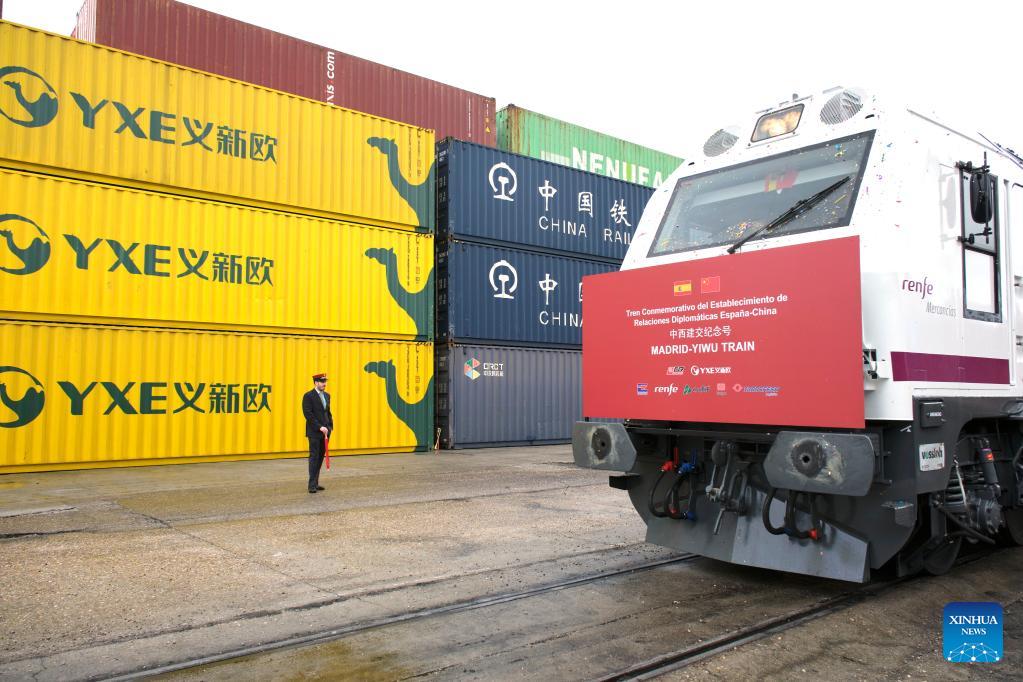
A scene from the welcome ceremony for the 10,000th trip made by China-Europe freight trains operated by the China-Europe Railway Express (Chongqing) in Duisburg, Germany, July 11, 2022. /Xinhua
A scene from the welcome ceremony for the 10,000th trip made by China-Europe freight trains operated by the China-Europe Railway Express (Chongqing) in Duisburg, Germany, July 11, 2022. /Xinhua
Editor's note: Ruqiya Anwar, a special commentator on current affairs for CGTN, is a PhD scholar of Media and Communication Studies in Pakistan. The article reflects the author's opinions and not necessarily the views of CGTN.
Italian Prime Minister Giorgia Meloni maintained that Italy can retain strong ties with China even if it withdraws from the Belt and Road Initiative (BRI). Italy is the only major Western country to join the BRI, which invests in infrastructure to link China with the rest of Asia, Europe, and other regions. Meloni indicated that positive relations with Beijing can be maintained without being part of an overall strategic plan.
Given China's potential for further economic growth and its investment in other emerging markets, bolstering trade cooperation between Europe and China will benefit the people on both sides. This collaboration signifies a transition towards a more equitable and interconnected global system, delivering stability, prosperity, and mutual advantage to both continents and beyond.
Notably, in the framework of the BRI, Asia-Europe collaboration has been developing rapidly, strengthening ties between the two regions. The synergy between the BRI and the Eurasian Economic Union (EAEU), a regional economic union made up of Armenia, Belarus, Kazakhstan, Kyrgyzstan, and Russia, is only going to grow stronger as this partnership continues to develop. All of the countries involved can open up new doors for trade and collaboration between Asia and Europe if they work together towards common aims.
In a multipolar world, China in particular is ready to engage with all parties involved to promote peace, development, collaboration, and mutual benefit, therefore launching a new era and opening a new chapter in the history of human civilization.
In addition, China's commitment to inclusiveness promises that all countries, irrespective of their size or location, will be able to take part in and reap the benefits of this cooperation. China's goal is to promote long-term progress and mutual prosperity through collaborating on shared problems and exchanging expertise.
In an unstable and changing world, advancing Asia-Europe cooperation will have a significant effect on global development, as well as the welfare of Eurasian society. The BRI continues to serve as a global public good and international cooperation platform.

A freight train heading for Yiwu of China departs from Madrid, Spain, March 9, 2023. /Xinhua
A freight train heading for Yiwu of China departs from Madrid, Spain, March 9, 2023. /Xinhua
Since the initiative's introduction in 2013, more than 3,000 cooperation projects have been started, totaling around $1 trillion in investment. As a result, many countries have been able to build the infrastructure they had always wanted, including bridges, railroads, and other types of infrastructure, as well as reduce poverty. As of now, the initiative has created 420,000 employments and accelerated economic growth in an increasing number of countries.
Already, the BRI has achieved remarkable success in advancing communication and trade between Asia and Europe. It has laid the groundwork for better collaboration through its emphasis on infrastructure development, trade facilitation, and people-to-people contacts.
The BRI can take advantage of the tremendous opportunities in Eurasia by working closely with the EAEU. The goals of the BRI are highly compatible with the EAEU's vision of economic unity, reduced regulations, and harmonized customs procedures. They can work together to improve connectivity, lower trade barriers, and encourage investment. By working together, Asia and Europe can close their development gap, leading to greater regional stability and prosperity.
The BRI has facilitated the creation of transport and logistics corridors, supported trade and investment facilitation, and encouraged infrastructure development in the Eurasian region, all of which have improved Eurasian economic ties.
China recognizes the importance of collaboration, especially with EAEU member states, in order to attain the shared objectives of peace, development, and mutual benefit. China's willingness to collaborate with all parties demonstrates its commitment to achieving a prosperous, interlinked future across both continents. By pooling resources, exchanging information, and addressing common challenges, China seeks to foster an environment suitable for sustainable development and mutual prosperity.
Asia-Europe cooperation, strengthened within the BRI and EAEU frameworks, offers an opportunity to write a new chapter in civilizational progress. This collaboration advances a balanced and integrated global order in a multipolar world. Countries can work together to address climate change, economic inequality, and geopolitical concerns.
(If you want to contribute and have specific expertise, please contact us at opinions@cgtn.com. Follow @thouse_opinions on Twitter to discover the latest commentaries in the CGTN Opinion Section.)